Linking Volcanism, Hydrothermal Venting, and Ordovician/Silurian Marine Organic-Rich Sediments in the Eastern Sichuan Basin, Southwest China
Abstract
1. Introduction
2. Geological Background
3. Samples and Analytical Methods
3.1. Black Shale and Carbonate Rock Samples from the Ordovician/Silurian Boundary
3.2. Methodology
3.2.1. Total Organic Carbon and Total Sulfur Content Analysis
3.2.2. Mineralogical Composition and Major Element Analysis
3.2.3. ICP-MS Trace Element Analysis
4. Results
4.1. Mineralogical Compositions, TOC and TS Contents
4.2. Major Element Composition of Samples
4.3. Trace Element Composition of Samples
5. Discussion
5.1. Recognizing Non-Visible Volcanic Input Within Ordovician/Silurian Black Shales in the Shizhu Area
5.2. Influence of Non-Visible Volcanic Input on Metal Compositions of Black Shales
5.3. Redox Variation Controls Organic Matter Accumulation in Ordovician/Silurian Black Shales
5.4. Divergent Paleoredox Metal Proxies and Evidence of Hydrothermal Venting
5.5. Volcanism–Hydrothermal–OM Interactions and Their Impact on Metal Indicators of Source Rocks
6. Conclusions
Supplementary Materials
Author Contributions
Funding
Institutional Review Board Statement
Informed Consent Statement
Data Availability Statement
Acknowledgments
Conflicts of Interest
References
- Gómez-Tuena, A.; Mori, L.; Rincón-Herrera, N.E.; Ortega-Gutiérrez, F.; Solé, J.; Iriondo, A. The origin of a primitive trondhjemite from the Trans-Mexican Volcanic Belt and its implications for the construction of a modern continental arc. Geology 2008, 36, 471–474. [Google Scholar] [CrossRef]
- Watson, E.J.; Swindles, G.T.; Savov, I.P.; Lawson, I.T.; Connor, C.B.; Wilson, J.A. Estimating the frequency of volcanic ash clouds over northern Europe. Earth Planet. Sci. Lett. 2017, 460, 41–49. [Google Scholar] [CrossRef]
- Yan, H.; Pi, D.-H.; Jiang, S.-Y.; Hao, W.; Mänd, K.; Robbins, L.J.; Li, L.; Konhauser, K.O. New constraints on the onset age of the Emeishan LIP volcanism and implications for the Guadalupian mass extinction. Lithos 2020, 360–361, 105441. [Google Scholar] [CrossRef]
- Du, X.; Jia, J.; Zhao, K.; Shi, J.; Shu, Y.; Liu, Z.; Duan, D. Was the volcanism during the Ordovician-Silurian transition in South China actually global in extent? Evidence from the distribution of volcanic ash beds in black shales. Mar. Pet. Geol. 2021, 123, 104721. [Google Scholar] [CrossRef]
- Fisher, R.V.; Smith, G.A. Sedimentation in volcanic settings. Spec. Publ. Soc. Econ. Paleontol. Mineral. 1991, 45, 257. [Google Scholar]
- Di Capua, A.; De Rosa, R.; Kereszturi, G.; Le Pera, E.; Rosi, M.; Watt, S.F.L. From volcanoes to sedimentary system. In Volcanic Processes in the Sedimentary Record: When Volcanoes Meet the Environment; Di Capua, A., De Rosa, R., Kereszturi, G., Le Pera, E., Rosi, M., Watt, S.F.L., Eds.; Special Publication 520; Geological Society of London: London, UK, 2022; pp. 11–27. [Google Scholar]
- Vermeij, G.J. Economics, volcanoes, and Phanerozoic revolutions. Paleobiology 1995, 21, 125–152. [Google Scholar] [CrossRef]
- Jolivet, M.; Brunel, M.; Seward, D.; Xu, Z.; Yang, J.; Malavieille, J.; Roger, F.; Leyreloup, A.; Arnaud, N.; Wu, C. Neogene extension and volcanism in the Kunlun Fault Zone, northern Tibet: New constraints on the age of the Kunlun Fult. Tectonics 2003, 22, 7-1–7-23. [Google Scholar] [CrossRef]
- Horton, F. Did phosphorus derived from the weathering of large igneous provinces fertilize the Neoproterozoic ocean? Geochem. Geophys. Geosyst. 2015, 16, 1723–1738. [Google Scholar] [CrossRef]
- Yang, S.; Hu, W.; Fan, J.; Deng, Y. New geochemical identification fingerprints of volcanism during the Ordovician-Silurian transition and its implications for biological and environmental evolution. Earth-Sci. Rev. 2022, 228, 104016. [Google Scholar] [CrossRef]
- Van de Schootbrugge, B.; Quan, T.M.; Lindström, S.; Püttmann, W.; Heunisch, C.; Pross, J.; Fiebig, J.; Petschick, R.; Röhling, H.G.; Richoz, S.; et al. Floral changes across the Triassic/Jurassic boundary linked to flood basalt volcanism. Nat. Geosci. 2009, 2, 589–594. [Google Scholar] [CrossRef]
- Pálfy, J.; Zajzon, N. Environmental changes across the Triassic–Jurassic boundary and coeval volcanism inferred from elemental geochemistry and mineralogy in the Kendlbachgraben section (Northern Calcareous Alps, Austria). Earth Planet. Sci. Lett. 2012, 335–336, 121–134. [Google Scholar] [CrossRef]
- Wu, L.; Lu, Y.; Jiang, S.; Liu, X.; Liu, Z.; Lu, Y. Relationship between the origin of organic-rich shale and geological events of the Upper Ordovician-Lower Silurian in the Upper Yangtze area. Mar. Pet. Geol. 2019, 102, 74–85. [Google Scholar] [CrossRef]
- Zhang, K.; Liu, R.; Liu, Z.; Li, B.; Han, J.; Zhao, K. Influence of volcanic and hydrothermal activity on organic matter enrichment in the Upper Triassic Yanchang Formation, southern Ordos Basin, Central China. Mar. Pet. Geol. 2020, 112, 104059. [Google Scholar] [CrossRef]
- Tribovillard, N.; Algeo, T.J.; Lyons, T.; Riboulleau, A. Trace metals as paleoredox and paleoproductivity proxies: An update. Chem. Geol. 2006, 232, 12–32. [Google Scholar] [CrossRef]
- Wang, N.; Li, M.; Tian, X.; Hong, H.; Wen, L.; Wang, W. Climate-ocean control on the depositional watermass conditions and organic matter enrichment in lower cambrian black shale in the upper Yangtze Platform. Mar. Pet. Geol. 2020, 120, 104570. [Google Scholar] [CrossRef]
- Abdi, Z.; Rimmer, S.M.; Rowe, H.D.; Nordeng, S. Trace-metal enrichment mechanisms in Bakken Formation black shales, Williston Basin, North Dakota, USA. Chem. Geol. 2024, 646, 121892. [Google Scholar] [CrossRef]
- Środoń, J.; Clauer, N.; Huff, W.; Dudek, T.; Banaś, M. K-Ar dating of the Lower Palaeozoic K-bentonites from the Baltic Basin and the Baltic Shield: Implications for the role of temperature and time in the illitization of smectite. Clay Miner. 2009, 44, 361–387. [Google Scholar] [CrossRef]
- Su, W.; Huff, W.D.; Ettensohn, F.R.; Liu, X.; Zhang, J.; Li, Z. K-bentonite, black-shale and flysch successions at the Ordovician–Silurian transition, South China: Possible sedimentary responses to the accretion of Cathaysia to the Yangtze Block and its implications for the evolution of Gondwana. Gondwana Res. 2009, 15, 111–130. [Google Scholar] [CrossRef]
- Thompson, C.K.; Kah, L.C.; Astini, R.; Bowring, S.A.; Buchwaldt, R. Bentonite geochronology, marine geochemistry, and the Great Ordovician Biodiversification Event (GOBE). Palaeogeogr. Palaeoclimatol. Palaeoecol. 2012, 321–322, 88–101. [Google Scholar] [CrossRef]
- Xiao, B.; Xiong, L.; Zhao, Z.; Fu, X.; Zhao, Z.; Hou, H.; Liu, S. Late Ordovician-Early Silurian extension of the northern margin of the Upper Yangtze Platform (South China) and its impact on organic matter accumulation. J. Pet. Sci. Eng. 2023, 220, 111238. [Google Scholar] [CrossRef]
- Garven, G.; Bull, S.; Large, R. Hydrothermal fluid flow models of stratiform ore genesis in the McArthur Basin, Northern Territory, Australia. Geofluids 2001, 1, 289–311. [Google Scholar] [CrossRef]
- Su, A.; Chen, H.; Feng, Y.; Zhao, J.; Ai Duc, N.; Wang, Z.; Long, X. Dating and characterizing primary gas accumulation in Precambrian dolomite reservoirs, Central Sichuan Basin, China: Insights from pyrobitumen Re-Os and dolomite U-Pb geochronology. Precambrian Res. 2020, 350, 105897. [Google Scholar] [CrossRef]
- Mara, P.; Nelson, R.K.; Reddy, C.M.; Teske, A.; Edgcomb, V.P. Sterane and hopane biomarkers capture microbial transformations of complex hydrocarbons in young hydrothermal Guaymas Basin sediments. Commun. Earth Environ. 2022, 3, 250. [Google Scholar] [CrossRef]
- Liu, Z.; Yan, D.; Niu, X. Pyrite concretions in the Lower Cambrian Niutitang Formation, South China: Response to hydrothermal activity. J. Earth Sci. 2023, 34, 1053–1067. [Google Scholar] [CrossRef]
- Li, S.; Guo, X.; Wang, B.; Cao, Z.; Xu, H.; Chen, J. Recognition of a hydrothermally linked oil accumulation process in the Tahe oil field, northwestern China, with organic geochemistry, Re-Os, and U-Pb geochronology. AAPG Bull. 2024, 108, 1485–1508. [Google Scholar] [CrossRef]
- Large, R.R.; Mukherjee, I.; Gregory, D.D.; Steadman, J.A.; Maslennikov, V.V.; Meffre, S. Ocean and atmosphere geochemical proxies derived from trace elements in marine pyrite: Implications for ore genesis in sedimentary basins. Econ. Geol. 2017, 112, 423–450. [Google Scholar] [CrossRef]
- Mukherjee, I.; Large, R.R.; Corkrey, R.; Danyushevsky, L.V. The boring billion, a slingshot for complex life on Earth. Sci. Rep. 2018, 8, 4432. [Google Scholar] [CrossRef]
- Deng, Q.; Wang, H.; Wei, Z.; Li, S.; Zhang, H.; Liu, H.; Lekan Faboya, O.; Cheng, B.; Liao, Z. Different accumulation mechanisms of organic matter in Cambrian sedimentary successions in the western and northeastern margins of the Tarim Basin, NW China. J. Asian Earth Sci. 2021, 207, 104660. [Google Scholar] [CrossRef]
- Jin, Z.; Zhu, D.; Zhang, X.; Hu, W.; Song, Y. Hydrothermally fluoritized Ordovician carbonates as reservoir rocks in the Tazhong area, central Tarim Basin, NW China. J. Pet. Geol. 2006, 29, 27–40. [Google Scholar] [CrossRef]
- Keith, M.; Häckel, F.; Haase, K.M.; Schwarz-Schampera, U.; Klemd, R. Trace element systematics of pyrite from submarine hydrothermal vents. Ore Geol. Rev. 2016, 72, 728–745. [Google Scholar] [CrossRef]
- Giorno, M.; Barale, L.; Bertok, C.; Frenzel, M.; Looser, N.; Guillong, M.; Bernasconi, S.M.; Martire, L. Sulfide-associated hydrothermal dolomite and calcite reveal a shallow burial depth for Alpine-type Zn-(Pb) deposits. Geology 2022, 50, 853–858. [Google Scholar] [CrossRef]
- Li, S.; Wang, X.-C.; Hu, S.-Y.; Guagliardo, P.; Kilburn, M.; Golding, S.D.; Rodrigues, S.; Bourdet, J. Recognition of a widespread Paleoproterozoic hydrothermal system in the southern McArthur Basin, northern Australia, by in-situ analysis of fine-grained pyrite and spatially-associated solid bitumen in the Lamont Pass palaeohigh. Ore Geol. Rev. 2022, 144, 104834. [Google Scholar] [CrossRef]
- Simoneit, B.R.T.; Lonsdale, P.F. Hydrothermal petroleum in mineralized mounds at the seabed of Guaymas Basin. Nature 1982, 295, 198–202. [Google Scholar] [CrossRef]
- Hunt, J.M. Generation and migration of petroleum from abnormally pressured fluid compartments. AAPG Bull. 1990, 74, 1–12. [Google Scholar]
- Finlay, A.J.; Selby, D.; Osborne, M.J.; Finucane, D. Fault-charged mantle-fluid contamination of United Kingdom North Sea oils: Insights from Re-Os isotopes. Geology 2010, 38, 979–982. [Google Scholar] [CrossRef]
- Simoneit, B.R. Hydrothermal petroleum: Genesis, migration, and deposition in Guaymas Basin, Gulf of California. Can. J. Earth Sci. 1985, 22, 1919–1929. [Google Scholar] [CrossRef]
- Huang, H.; Zhang, S.; Su, J. Palaeozoic oil–source correlation in the Tarim Basin, NW China: A review. Org. Geochem. 2016, 94, 32–46. [Google Scholar] [CrossRef]
- Qiao, R.; Li, M.; Zhang, D.; Xiao, H. Geochemistry and accumulation of the ultra-deep Ordovician oils in the Shunbei oilfield, Tarim Basin: Coupling of reservoir secondary processes and filling events. Mar. Pet. Geol. 2024, 167, 106959. [Google Scholar] [CrossRef]
- Yan, D.; Chen, D.; Wang, Q.; Wang, J.; Wang, Z. Carbon and sulfur isotopic anomalies across the Ordovician–Silurian boundary on the Yangtze Platform, South China. Palaeogeogr. Palaeoclimatol. Palaeoecol. 2009, 274, 32–39. [Google Scholar] [CrossRef]
- Algeo, T.J.; Marenco, P.J.; Saltzman, M.R. Co-evolution of oceans, climate, and the biosphere during the ‘Ordovician Revolution’: A review. Palaeogeogr. Palaeoclimatol. Palaeoecol. 2016, 458, 1–11. [Google Scholar] [CrossRef]
- Qiu, Z.; Li, Y.; Xiong, W.; Fan, T.; Zhao, Q.; Zhang, Q.; Wang, Y.; Liu, W.; Liang, F.; Zhang, J.; et al. Revisiting paleoenvironmental changes on the Upper Yangtze Block during the Ordovician-Silurian transition: New insights from elemental geochemistry. Sediment. Geol. 2023, 450, 106377. [Google Scholar] [CrossRef]
- Munnecke, A.; Calner, M.; Harper, D.A.T.; Servais, T. Ordovician and Silurian sea–water chemistry, sea level, and climate: A synopsis. Palaeogeogr. Palaeoclimatol. Palaeoecol. 2010, 296, 389–413. [Google Scholar] [CrossRef]
- Mustafa, K.A.; Sephton, M.A.; Watson, J.S.; Spathopoulos, F.; Krzywiec, P. Organic geochemical characteristics of black shales across the Ordovician–Silurian boundary in the Holy Cross Mountains, central Poland. Mar. Pet. Geol. 2015, 66, 1042–1055. [Google Scholar] [CrossRef]
- Myrow, P.M.; Fike, D.A.; Malmskog, E.; Leslie, S.A.; Zhang, T.; Singh, B.P.; Chaubey, R.S.; Prasad, S.K. Ordovician–Silurian boundary strata of the Indian Himalaya: Record of the latest Ordovician Boda event. Geol. Soc. Am. Bull. 2018, 131, 881–898. [Google Scholar] [CrossRef]
- Orth, C.J.; Gilmore, J.S.; Quintana, L.R.; Sheehan, P.M. Terminal Ordovician extinction: Geochemical analysis of the Ordovician/Silurian boundary, Anticosti Island, Quebec. Geology 1986, 14, 433–436. [Google Scholar] [CrossRef]
- Yang, R.; He, S.; Hu, Q.; Hu, D.; Zhang, S.; Yi, J. Pore characterization and methane sorption capacity of over-mature organic-rich Wufeng and Longmaxi shales in the southeast Sichuan Basin, China. Mar. Pet. Geol. 2016, 77, 247–261. [Google Scholar] [CrossRef]
- Zou, C.N.; Zhu, R.K.; Chen, Z.Q.; Ogg, J.G.; Wu, S.T.; Dong, D.Z.; Qiu, Z.; Wang, Y.M.; Wang, L.; Lin, S.H.; et al. Organic-matter-rich shales of China. Earth-Sci. Rev. 2019, 189, 51–78. [Google Scholar] [CrossRef]
- Guo, T. The Fuling Shale Gas Field—A highly productive Silurian gas shale with high thermal maturity and complex evolution history, southeastern Sichuan Basin, China. Interpretation 2015, 3, SJ25–SJ34. [Google Scholar] [CrossRef]
- Yang, R.; He, S.; Wang, X.; Hu, Q.; Hu, D.; Yi, J. Paleo-ocean redox environments of the Upper Ordovician Wufeng and the first member in lower Silurian Longmaxi formations in the Jiaoshiba area, Sichuan Basin. Can. J. Earth Sci. 2016, 53, 426–440. [Google Scholar] [CrossRef]
- Gao, J.; He, S.; Zhao, J.; Yi, J. Geothermometry and geobarometry of overpressured lower Paleozoic gas shales in the Jiaoshiba field, Central China: Insight from fluid inclusions in fracture cements. Mar. Pet. Geol. 2017, 83, 124–139. [Google Scholar] [CrossRef]
- Dong, T.; He, S.; Chen, M.; Hou, Y.; Guo, X.; Wei, C.; Han, Y.; Yang, R. Quartz types and origins in the paleozoic Wufeng-Longmaxi Formations, Eastern Sichuan Basin, China: Implications for porosity preservation in shale reservoirs. Mar. Pet. Geol. 2019, 106, 62–73. [Google Scholar] [CrossRef]
- Ge, X.Y.; Mou, C.L.; Yu, Q.; Liu, W.; Men, X.; He, J.L. The geochemistry of the sedimentary rocks from the Huadi No. 1 well in the Wufeng-Longmaxi formations (Upper Ordovician-Lower Silurian), South China, with implications for paleoweathering, provenance, tectonic setting and paleoclimate. Mar. Pet. Geol. 2019, 103, 646–660. [Google Scholar] [CrossRef]
- Guo, X.; Qin, Z.; Yang, R.; Dong, T.; He, S.; Hao, F.; Yi, J.; Shu, Z.; Bao, H.; Liu, K. Comparison of pore systems of clay-rich and silica-rich gas shales in the lower Silurian Longmaxi formation from the Jiaoshiba area in the eastern Sichuan Basin, China. Mar. Pet. Geol. 2019, 101, 265–280. [Google Scholar] [CrossRef]
- Zhang, Y.Y.; He, Z.L.; Lu, S.F.; Jiang, S.; Xiao, D.S.; Long, S.X.; Gao, B.; Du, W.; Zhao, J.H.; Chen, G.H.; et al. Characteristics of microorganisms and origin of organic matter in Wufeng Formation and Longmaxi Formation in Sichuan Basin, South China. Mar. Pet. Geol. 2020, 111, 363–374. [Google Scholar] [CrossRef]
- Hu, X.; Müller, I.A.; Zhao, A.; Ziegler, M.; Chen, Q.; Han, L.; Shi, Z. Clumped isotope thermometry reveals diagenetic origin of the dolomite layer within late Ordovician black shale of the Guanyinqiao Bed (SW China). Chem. Geol. 2022, 588, 120641. [Google Scholar] [CrossRef]
- Wang, Y.; Li, X.; Wang, H.; Jiang, S.; Chen, B.; Ma, J.; Dai, B. Developmental characteristics and geological significance of the bentonite in the Upper Ordovician Wufeng—Lower Silurian Longmaxi Formation in eastern Sichuan Basin, SW China. Pet. Explor. Dev. 2019, 46, 687–700. [Google Scholar] [CrossRef]
- Watson, M.P.; Hayward, A.B.; Parkinson, D.N.; Zhang, Z.M. Plate tectonic history, basin development and petroleum source rock deposition onshore China. Mar. Pet. Geol. 1987, 4, 205–225. [Google Scholar] [CrossRef]
- Yao, S.; Gong, Y.; Hu, X.; Zhou, Z.; Shen, C.; Pi, D.; Xiong, S.; Tan, M. The main metallogenic systems and metallogenic lineages around the Middle and Upper Yangtze Block. Earth Sci. Front. 2020, 27, 218–231. [Google Scholar]
- Hao, F.; Guo, T.; Zhu, Y.; Cai, X.; Zou, H.; Li, P. Evidence for multiple stages of oil cracking and thermochemical sulfate reduction in the Puguang gas field, Sichuan Basin, China. AAPG Bull. 2008, 92, 611–637. [Google Scholar] [CrossRef]
- Richardson, N.J.; Densmore, A.L.; Seward, D.; Fowler, A.; Wipf, M.; Ellis, M.A.; Yong, L.; Zhang, Y. Extraordinary denudation in the Sichuan Basin: Insights from low-temperature thermochronology adjacent to the eastern margin of the Tibetan Plateau. J. Geophys. Res. 2008, 113, B04409. [Google Scholar] [CrossRef]
- Gao, J.; He, S.; Zhao, J.X.; He, Z.L.; Wu, C.W.; Fen, Y.X.; Nguyen, A.D.; Zhou, J.X.; Yi, Z.X. Sm-Nd isochron dating and geochemical (rare earth elements, Sr-87/Sr-86, delta O-18, delta C-13) characterization of calcite veins in the Jiaoshiba shale gas field, China: Implications for the mechanisms of vein formation in shale gas systems. Geol. Soc. Am. Bull. 2020, 132, 1722–1740. [Google Scholar] [CrossRef]
- Gao, J.; Li, X.; Cheng, G.; Luo, H.; Zhu, H. Structural evolution and characterization of organic-rich shale from macroscopic to microscopic resolution: The significance of tectonic activity. Adv. Geo-Energy Res. 2023, 10, 84–90. [Google Scholar] [CrossRef]
- Gao, J.; Li, H.; He, Z.; Cai, X.; Li, S.; Liu, G.; Yuan, Y.; Lin, J.; Li, Z. Multi-stage hydrocarbon accumulation in Cambrian Xixiangchi Group, Pingqiao area, southeastern Sichuan and its implications for hydrocarbon exploration. Earth Sci. Front. 2023, 30, 263–276. [Google Scholar]
- Wang, Y.X.; Xu, S.; Hao, F.; Lu, Y.B.; Shu, Z.G.; Yan, D.T.; Lu, Y.C. Geochemical and petrographic characteristics of Wufeng-Longmaxi shales, Jiaoshiba area, southwest China: Implications for organic matter differential accumulation. Mar. Pet. Geol. 2019, 102, 138–154. [Google Scholar] [CrossRef]
- Tuo, J.; Wu, C.; Zhang, M. Organic matter properties and shale gas potential of Paleozoic shales in Sichuan Basin, China. J. Nat. Gas Sci. Eng. 2016, 28, 434–446. [Google Scholar] [CrossRef]
- Zhang, Q.; Littke, R.; Zieger, L.; Shabani, M.; Tang, X.; Zhang, J.C. Ediacaran, Cambrian, Ordovician, Silurian and Permian shales of the Upper Yangtze Platform, South China: Deposition, thermal maturity and shale gas potential. Int. J. Coal Geol. 2019, 216, 20. [Google Scholar] [CrossRef]
- Nie, H.; Li, D.; Liu, G.; Lu, Z.; Hu, W.; Wang, R.; Zhang, G. An overview of the geology and production of the Fuling shale gas field, Sichuan Basin, China. Energy Geosci. 2020, 1, 147–164. [Google Scholar] [CrossRef]
- Gao, J.; Li, H.; He, Z.; Li, S.; Liu, G.; Yuan, Y.; Li, Y.; Li, T.; He, S. Pressure evolution, enrichment and preservation of normal-pressure shale gas in the Pengshui area of eastern Chongqing. Nat. Gas Ind. 2022, 42, 124–135. [Google Scholar]
- Li, S.; Wang, X.-C.; Wilde, S.A.; Chu, Z.-Y.; Li, C.-F.; He, S.; Liu, K.; Ma, X.; Zhang, Y. Revisiting rhenium-osmium isotopic investigations of petroleum systems: From geochemical behaviour to geological interpretation. J. Earth Sci. 2021, 32, 1226–1249. [Google Scholar] [CrossRef]
- Yang, R.; He, S.; Yi, J.; Hu, Q. Nano-scale pore structure and fractal dimension of organic-rich Wufeng-Longmaxi shale from Jiaoshiba area, Sichuan Basin: Investigations using FE-SEM, gas adsorption and helium pycnometry. Mar. Pet. Geol. 2016, 70, 27–45. [Google Scholar] [CrossRef]
- Yang, R.; Hao, F.; He, S.; He, C.; Guo, X.; Yi, J.; Hu, H.; Zhang, S.; Hu, Q. Experimental investigations on the geometry and connectivity of pore space in organic-rich Wufeng and Longmaxi shales. Mar. Pet. Geol. 2017, 84, 225–242. [Google Scholar] [CrossRef]
- Li, S.J.; Xiao, Q.L.; Cai, S.Y. Pyrite trace metal and sulfur isotopic compositions track metalliferous fluid circulation within the Ordovician/Silurian organic-rich black shales in the eastern Sichuan Basin, southwestern China. Int. J. Coal Geol. 2024, 294, 104617. [Google Scholar] [CrossRef]
- McKerrow, W.S.; Lambert, R.S.J.; Cocks, L.R.M. The Ordovician, Silurian and Devonian periods. Geol. Soc. Lond. Mem. 1985, 10, 73–80. [Google Scholar] [CrossRef]
- Liu, Y.; Wang, X.; Li, J.; Zhang, Y. Organic matter accumulation under the Middle-Upper Ordovician Wulalike Formation: Tectonic control and accumulation models. Sci. Rep. 2024, 14, 79356. [Google Scholar]
- Wang, C.; Dong, T.; He, Z.; Guo, X.; Liu, S. Hydrographic restriction conditions in the Middle and Upper Yangtze region during the Early Silurian post-glacial transgression. Palaeogeogr. Palaeoclimatol. Palaeoecol. 2024, 630, 105352. [Google Scholar]
- Liang, F.; Zhao, Q.; Zhang, Q.; Wang, Y.M.; Zhou, S.W.; Qiu, Z.; Liu, W.; Ran, B.; Sun, T. Controls of paleogeomorphology on organic matter accumulation as recorded in Ordovician-Silurian marine black shales in the western South China Block. Mar. Pet. Geol. 2025, 172, 107206. [Google Scholar] [CrossRef]
- Li, Y.F.; Tian, H.; Zhang, T.W.; Shen, B.J.; Shao, D.Y. Mercury evidence for volcanism driving environmental changes during the protracted Late Ordovician mass extinction and early Silurian recovery. Chem. Geol. 2025, 674, 122566. [Google Scholar] [CrossRef]
- Zhang, K.; Xi, Z.; Zhang, S.; Tang, S.; Lv, J.; Nie, H.; Lin, D. Characteristics of Organic Matter Types and Organic Matter Pore Development in Marine-Continental Transitional Shale. Geol. J. 2025. early view. [Google Scholar] [CrossRef]
- Nicolas, P.; Denis, L.; Zhang, S.X. Hudson Strait Platform and Basins Tectono-Sedimentary Element. Northeast Can. Can. J. Earth Sci. 2010, 47, 1317–1332. [Google Scholar]
- White, W.M. Geochemistry; John Wiley & Sons: Hoboken, NJ, USA, 2013. [Google Scholar]
- Wang, X.C.; Li, Z.X.; Li, X.H.; Li, Q.L.; Zhang, Q.R. Geochemical and Hf-Nd isotope data of Nanhua rift sedimentary and volcaniclastic rocks indicate a Neoproterozoic continental flood basalt provenance. Lithos 2011, 127, 427–440. [Google Scholar] [CrossRef]
- Rimmer, S.M. Geochemical paleoredox indicators in Devonian–Mississippian black shales, central Appalachian Basin (USA). Chem. Geol. 2004, 206, 373–391. [Google Scholar] [CrossRef]
- Nelson, D.M.; Tréguer, P.; Brzezinski, M.A.; Leynaert, A.; Quéguiner, B. Production and dissolution of biogenic silica in the ocean: Revised global estimates, comparison with regional data and relationship to biogenic sedimentation. Glob. Biogeochem. Cycles 1995, 9, 359–372. [Google Scholar] [CrossRef]
- Reitz, A.; Pfeifer, K.; de Lange, G.J.; Klump, J. Biogenic barium and the detrital Ba/Al ratio: A comparison of their direct and indirect determination. Mar. Geol. 2004, 204, 289–300. [Google Scholar] [CrossRef]
- Schoepfer, S.D.; Shen, J.; Wei, H.; Tyson, R.V.; Ingall, E.; Algeo, T.J. Total organic carbon, organic phosphorus, and biogenic barium fluxes as proxies for paleomarine productivity. Earth-Sci. Rev. 2015, 149, 23–52. [Google Scholar] [CrossRef]
- Dong, T.; Harris, N.B.; Ayranci, K. Relative sea-level cycles and organic matter accumulation in shales of the Middle and Upper Devonian Horn River Group, northeastern British Columbia, Canada: Insights into sediment flux, redox conditions, and bioproductivity. GSA Bull. 2017, 130, 859–880. [Google Scholar] [CrossRef]
- Algeo, T.J.; Maynard, J.B. Trace-element behavior and redox facies in core shales of Upper Pennsylvanian Kansas-type cyclothems. Chem. Geol. 2004, 206, 289–318. [Google Scholar] [CrossRef]
- Reinhard, C.T.; Planavsky, N.J.; Robbins, L.J.; Partin, C.A.; Gill, B.C.; Lalonde, S.V.; Bekker, A.; Konhauser, K.O.; Lyons, T.W. Proterozoic ocean redox and biogeochemical stasis. Proc. Natl. Acad. Sci. USA 2013, 110, 5357. [Google Scholar] [CrossRef]
- Dong, T.; Wang, C.; Liang, X.; Wang, G.; Jiang, S. Paleodepositional conditions and organic matter accumulation mechanisms in the Upper Ordovician-lower Silurian Wufeng-Longmaxi shales, Middle Yangtze region, South China. Mar. Pet. Geol. 2022, 143, 105823. [Google Scholar] [CrossRef]
- Partin, C.A.; Bekker, A.; Planavsky, N.J.; Scott, C.T.; Gill, B.C.; Li, C.; Podkovyrov, V.; Maslov, A.; Konhauser, K.O.; Lalonde, S.V.; et al. Large-scale fluctuations in Precambrian atmospheric and oceanic oxygen levels from the record of U in shales. Earth Planet. Sci. Lett. 2013, 369–370, 284–293. [Google Scholar] [CrossRef]
- Hunt, J.M. Petroleum Geochemistry and Geology, 2nd ed.; W.H. Freeman and Company: New York, NY, USA, 1996; p. 743. [Google Scholar]
- Tissot, B.P.; Welte, D.H. Petroleum Formation and Occurrence; Springer: Berlin/Heidelberg, Germany, 1984. [Google Scholar]
- Demaison, G.J.; Moore, G.T. Anoxic environments and oil source bed genesis. AAPG Bull. 1980, 2, 9–31. [Google Scholar] [CrossRef]
- Arthur, M.A.; Sageman, B.B. Marine Black Shales: Depositional Mechanisms and Environments of Ancient Deposits. Annu. Rev. Earth Planet. Sci. 1994, 22, 499–551. [Google Scholar] [CrossRef]
- Murphy, A.E.; Sageman, B.B.; Hollander, D.J.; Lyons, T.W.; Brett, C.E. Black shale deposition and faunal overturn in the Devonian Appalachian Basin: Clastic starvation, seasonal water-column mixing, and efficient biolimiting nutrient recycling. Paleoceanography 2000, 15, 280–291. [Google Scholar] [CrossRef]
- Shen, J.; Schoepfer, S.D.; Feng, Q.; Zhou, L.; Yu, J.; Song, H.; Wei, H.; Algeo, T.J. Marine productivity changes during the end-Permian crisis and Early Triassic recovery. Earth-Sci. Rev. 2015, 149, 136–162. [Google Scholar] [CrossRef]
- Yan, D.T.; Wang, H.; Fu, Q.L.; Chen, Z.H.; He, J.; Gao, Z. Geochemical characteristics in the Longmaxi Formation (Early Silurian) of South China: Implications for organic matter accumulation. Mar. Pet. Geol. 2015, 65, 290–301. [Google Scholar] [CrossRef]
- Hodge, V.F.; Johannesson, K.H.; Stetzenbach, K.J. Rhenium, molybdenum, and uranium in groundwater from the southern Great Basin, USA: Evidence for conservative behavior. Geochim. Cosmochim. Acta 1996, 60, 3197–3214. [Google Scholar] [CrossRef]
- Cohen, A.S.; Coe, A.L.; Harding, S.M.; Schwark, L. Osmium isotope evidence for the regulation of atmospheric CO2 by continental weathering. Geology 2004, 32, 157. [Google Scholar] [CrossRef]
- Cox, G.M.; Halverson, G.P.; Stevenson, R.K.; Vokaty, M.; Poirier, A.; Kunzmann, M.; Li, Z.-X.; Denyszyn, S.W.; Strauss, J.V.; Macdonald, F.A. Continental flood basalt weathering as a trigger for Neoproterozoic Snowball Earth. Earth Planet. Sci. Lett. 2016, 446, 89–99. [Google Scholar] [CrossRef]
- Murray, J.; Jagoutz, O. Palaeozoic cooling modulated by ophiolite weathering through organic carbon preservation. Nat. Geosci. 2024, 17, 88–93. [Google Scholar] [CrossRef]
- Wang, Q.; Hao, F.; Xu, C.; Zou, H. Paleolimnological environments and the formation of high quality source rocks in the Bohai Bay Basin: An integrated geochemical study of biomarkers, stable carbon and oxygen isotopes, and trace elements. J. Pet. Sci. Eng. 2020, 195, 107753. [Google Scholar] [CrossRef]
- Huang, W.; Fang, Q.; Chu, R.; Zhang, S.; Yang, T.; Li, H.; Shi, M.; Wu, H. Millennial climate variability and organic matter accumulation under icehouse conditions. Gondwana Res. 2024, 130, 187–202. [Google Scholar] [CrossRef]
- Katz, B.J. Controlling Factors on Source Rock Development-A Review of Productivity, Preservation, and Sedimentation Rate. In The Deposition of Organic-Carbon-Rich Sediments: Models, Mechanisms, and Consequences; Harris, N.B., Ed.; SEPM Society for Sedimentary Geology: Tulsa, OK, USA, 2005; pp. 7–16. [Google Scholar]
- Khairy, A.; El Diasty, W.S.; Uguna, C.N.; Peters, K.E.; Vane, C.H.; Snape, C.E.; Meredith, W. Geochemical assessment and hydrocarbon potential of Oligocene–Pliocene source rocks from northeast onshore Nile Delta, Egypt. Int. J. Coal Geol. 2023, 274, 104283. [Google Scholar] [CrossRef]
- Yang, X.; Yan, D.; Zhang, B.; Zhang, L.; Wei, X.; Li, T.; Zhang, J.; She, X. The impact of volcanic activity on the deposition of organic-rich shales: Evidence from carbon isotope and geochemical compositions. Mar. Pet. Geol. 2021, 128, 105010. [Google Scholar] [CrossRef]
- Wallace, P.J. Volcanic SO2 emissions and the abundance and distribution of exsolved gas in magma bodies. J. Volcanol. Geotherm. Res. 2001, 108, 85–106. [Google Scholar] [CrossRef]
- Gregory, D.D.; Large, R.R.; Halpin, J.A.; Baturina, E.L.; Lyons, T.W.; Wu, S.; Danyushevsky, L.; Sack, P.J.; Chappaz, A.; Maslennikov, V.V.; et al. Trace element content of sedimentary pyrite in black shales. Econ. Geol. 2015, 110, 1389–1410. [Google Scholar] [CrossRef]
- Berner, R.A. Sedimentary pyrite formation: An update. Geochim. Cosmochim. Acta 1984, 48, 605–615. [Google Scholar] [CrossRef]
- Large, R.R.; Halpin, J.A.; Danyushevsky, L.V.; Maslennikov, V.V.; Bull, S.W.; Long, J.A.; Gregory, D.D.; Lounejeva, E.; Lyons, T.W.; Sack, P.J. Trace element content of sedimentary pyrite as a new proxy for deep-time ocean–atmosphere evolution. Earth Planet. Sci. Lett. 2014, 389, 209–220. [Google Scholar] [CrossRef]
- Spinks, S.C.; Pearce, M.A.; Liu, W.; Kunzmann, M.; Ryan, C.G.; Moorhead, G.F.; Kirkham, R.; Blaikie, T.; Sheldon, H.A.; Schaubs, P.M.; et al. Carbonate Replacement as the Principal Ore Formation Process in the Proterozoic McArthur River (HYC) Sediment-Hosted Zn-Pb Deposit, Australia. Econ. Geol. 2021, 116, 693–718. [Google Scholar] [CrossRef]
- Mukherjee, I.; Large, R. Application of pyrite trace element chemistry to exploration for SEDEX style Zn-Pb deposits: McArthur Basin, Northern Territory, Australia. Ore Geol. Rev. 2017, 81, 1249–1270. [Google Scholar] [CrossRef]
- López, D.L.; Williams, S.N. Catastrophic volcanic collapse: Relation to hydrothermal processes. Science 1993, 260, 1794–1796. [Google Scholar] [CrossRef]
- Takahashi, K.; Takakura, S.; Matsushima, N.; Fujii, I. Relationship between volcanic activity and shallow hydrothermal system at Meakandake volcano, Japan, inferred from geomagnetic and audio-frequency magnetotelluric measurements. J. Volcanol. Geotherm. Res. 2018, 349, 351–369. [Google Scholar] [CrossRef]
- Wang, L.; Han, Y.; Lou, D.; He, Z.; Guo, X.; Steele-MacInnis, M. Hydrothermal petroleum related to intracontinental magmatism in the Bohai Bay Basin, eastern China. Mar. Pet. Geol. 2024, 167, 106982. [Google Scholar] [CrossRef]
- Leach, D.L.; Viets, J.G.; Kozlowski, A.; Kibitlewski, S.; Sangster, D.F. Geology, Geochemistry, and Genesis of the Silesia-Cracow Zinc-Lead District, Southern Poland, Carbonate-Hosted Lead-Zinc Deposits: 75th Anniversary Volume; Society of Economic Geologists: Littleton, CO, USA, 1996. [Google Scholar]
- Cohen, A.S.; Coe, A.L. New geochemical evidence for the onset of volcanism in the Central Atlantic magmatic province and environmental change at the Triassic-Jurassic boundary. Geology 2002, 30, 267–270. [Google Scholar] [CrossRef]
- Billström, K.; Broman, C.; Larsson, A.; Schérsten, A.; Schmitt, M. Sandstone-hosted Pb-Zn deposits along the margin of the Scandinavian Caledonides and their possible relationship with nearby Pb-Zn vein mineralisation. Ore Geol. Rev. 2020, 127, 103839. [Google Scholar] [CrossRef]
- Jia, L.; Cai, C.; Wang, Z.; Li, H.; Liu, L.; Luo, Q.; Jiang, L. Calcite vein system and its importance in tracing paleowater flow and hydrocarbon migration in the Ordovician carbonates of the Tazhong area, Tarim Basin, China. AAPG Bull. 2020, 104, 2401–2428. [Google Scholar] [CrossRef]
- Jiu, B.; Huang, W.; Mu, N.; He, M. Effect of hydrothermal fluids on the ultra-deep Ordovician carbonate rocks in Tarim Basin, China. J. Pet. Sci. Eng. 2020, 194, 107445. [Google Scholar] [CrossRef]
- Wang, Q.; Yang, L.; Xu, X.; Santosh, M.; Wang, Y.; Wang, T.; Chen, F.; Wang, R.; Gao, L.; Liu, X.; et al. Multi-stage tectonics and metallogeny associated with Phanerozoic evolution of the South China Block: A holistic perspective from the Youjiang Basin. Earth-Sci. Rev. 2020, 211, 103405. [Google Scholar] [CrossRef]
- Sweeney, J.J.; Burnham, A.K. Evaluation of a simple model of vitrinite reflectance based on chemical kinetics. AAPG Bull. 1990, 74, 1559–1570. [Google Scholar]
- Lewan, M.; Spiro, B.; Illich, H.; Raiswell, R.; Mackenzie, A.; Durand, B.; Manning, D.; Comet, P.; Berner, R.; De Leeuw, J. Evaluation of petroleum generation by hydrous pyrolysis experimentation [and discussion]. Philos. Trans. R. Soc. Lond. A Math. Phys. Eng. Sci. 1985, 315, 123–134. [Google Scholar]
- Lewan, M.D.; Kotarba, M.J.; Wiecław, D.; Piestrzyński, A. Evaluating transition-metal catalysis in gas generation from the Permian Kupferschiefer by hydrous pyrolysis. Geochim. Cosmochim. Acta 2008, 72, 4069–4093. [Google Scholar] [CrossRef]
- Li, S.; Guo, X.; Zheng, L.; Han, Y. Semi-closed hydrous pyrolysis of type I source rock using formation water: Implications for biomarker behaviour under supercritical conditions. Mar. Pet. Geol. 2023, 158, 106510. [Google Scholar] [CrossRef]
- Reich, M.; Deditius, A.; Chryssoulis, S.; Li, J.W.; Ma, C.Q.; Parada, M.A.; Barra, F.; Mittermayr, F. Pyrite as a record of hydrothermal fluid evolution in a porphyry copper system: A SIMS/EMPA trace element study. Geochim. Cosmochim. Acta 2013, 104, 42–62. [Google Scholar] [CrossRef]
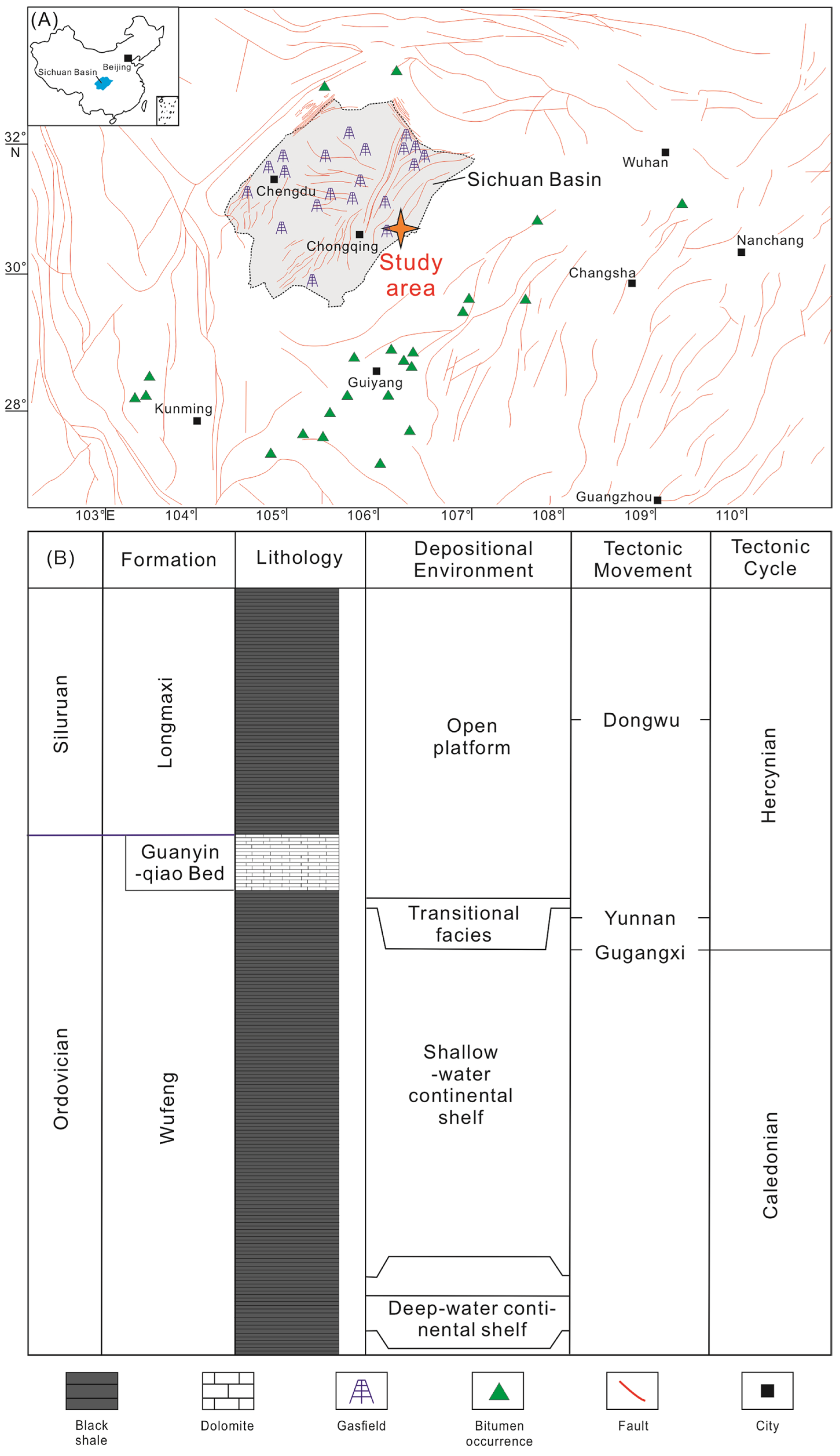
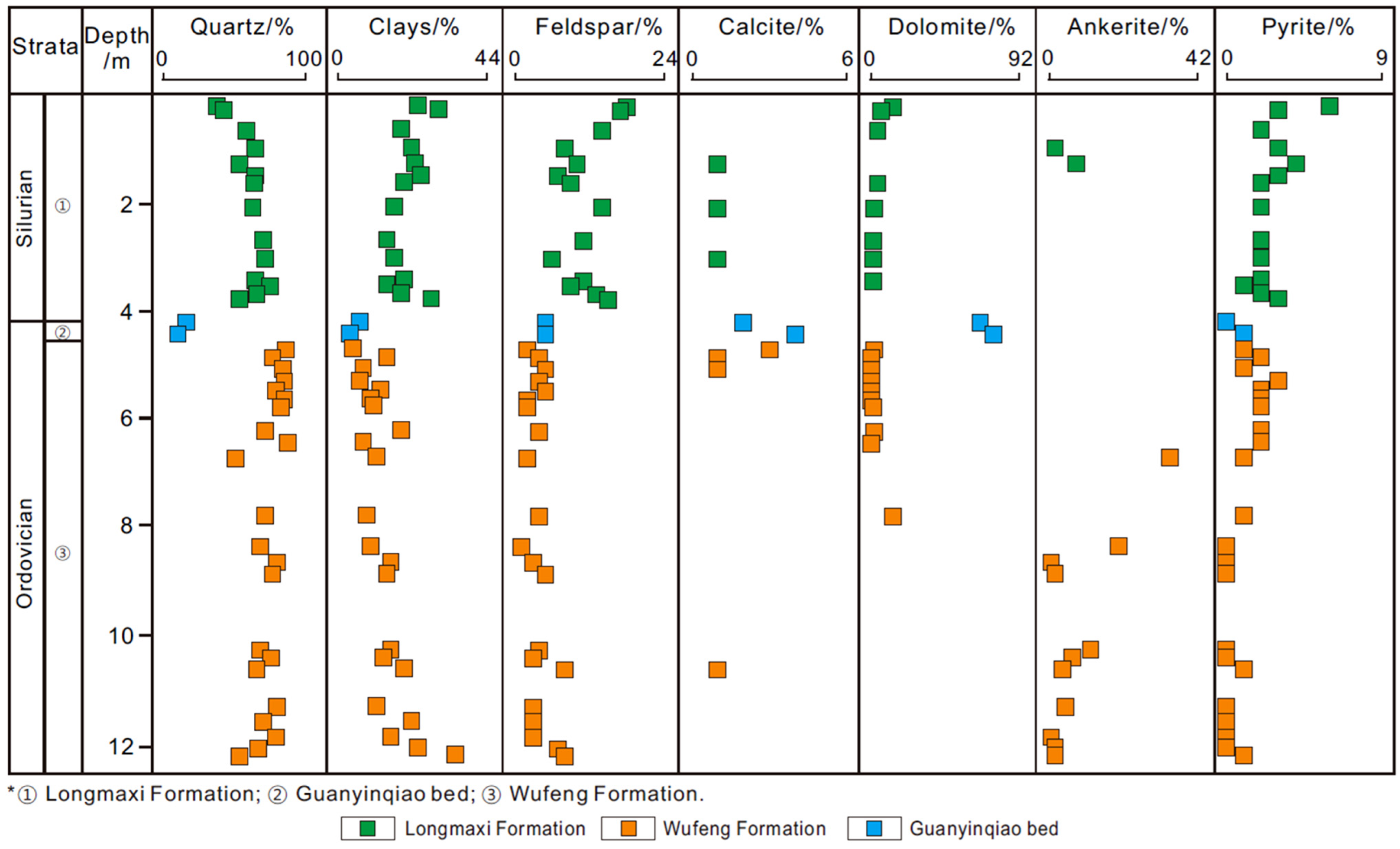
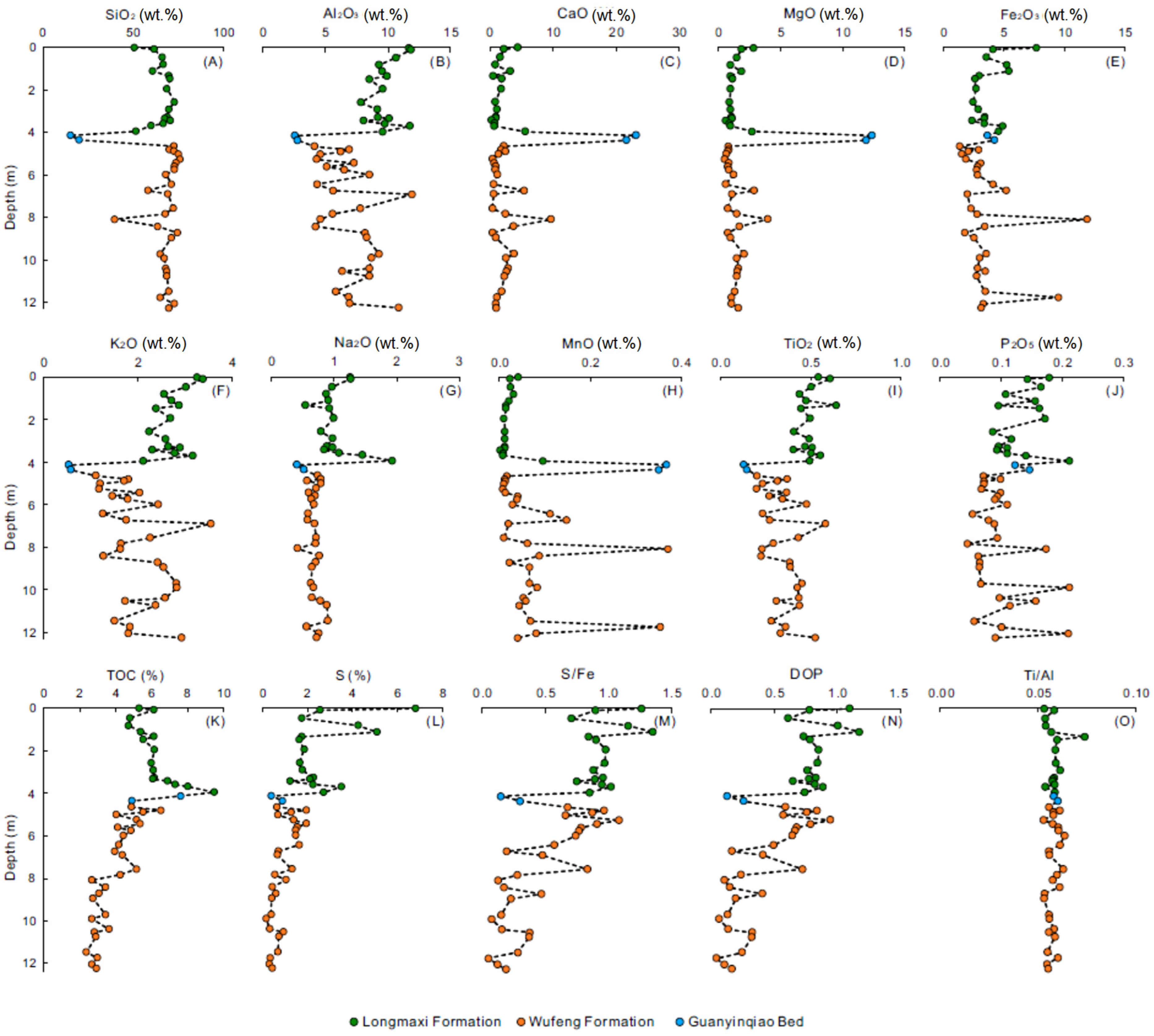
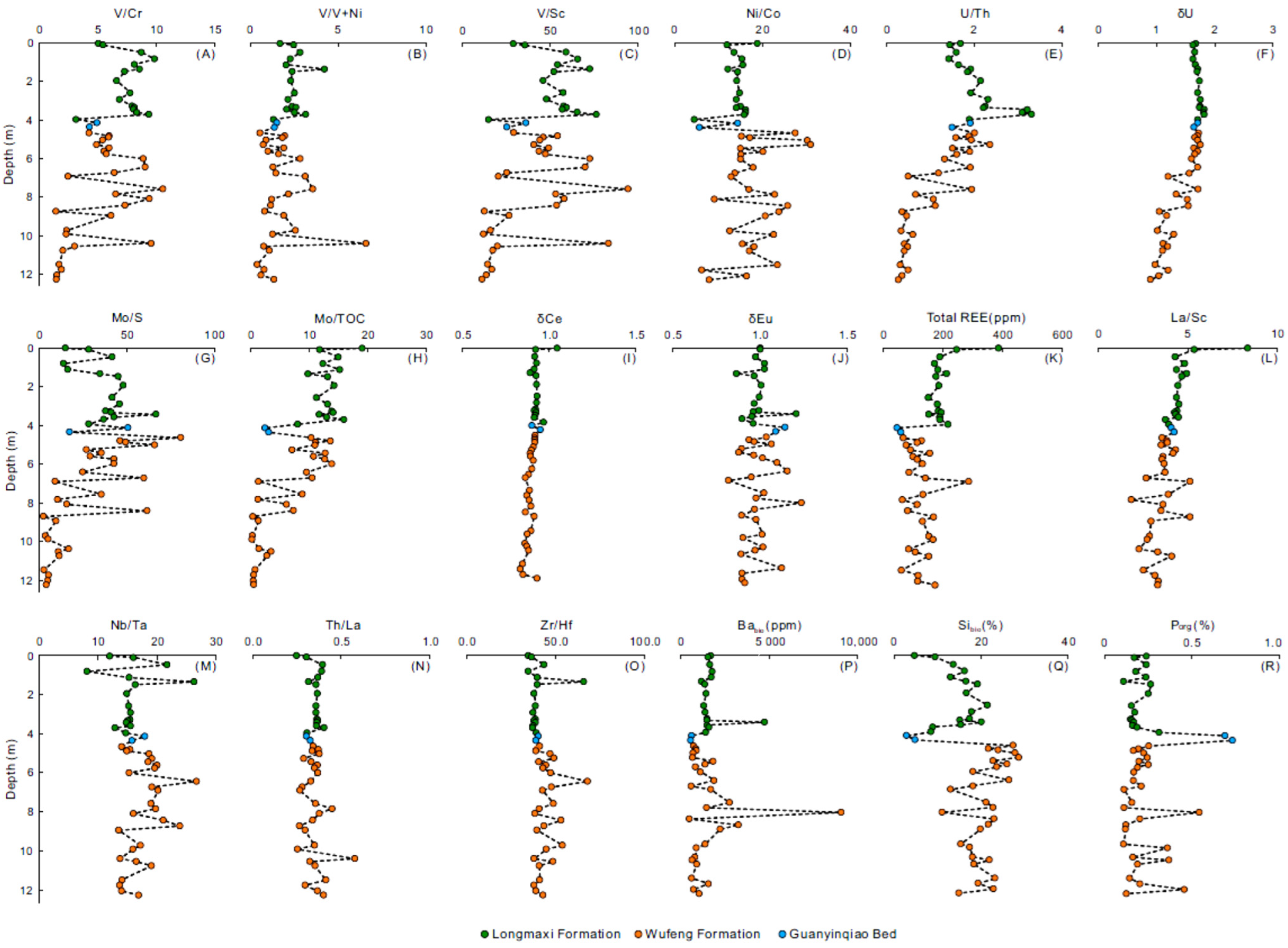

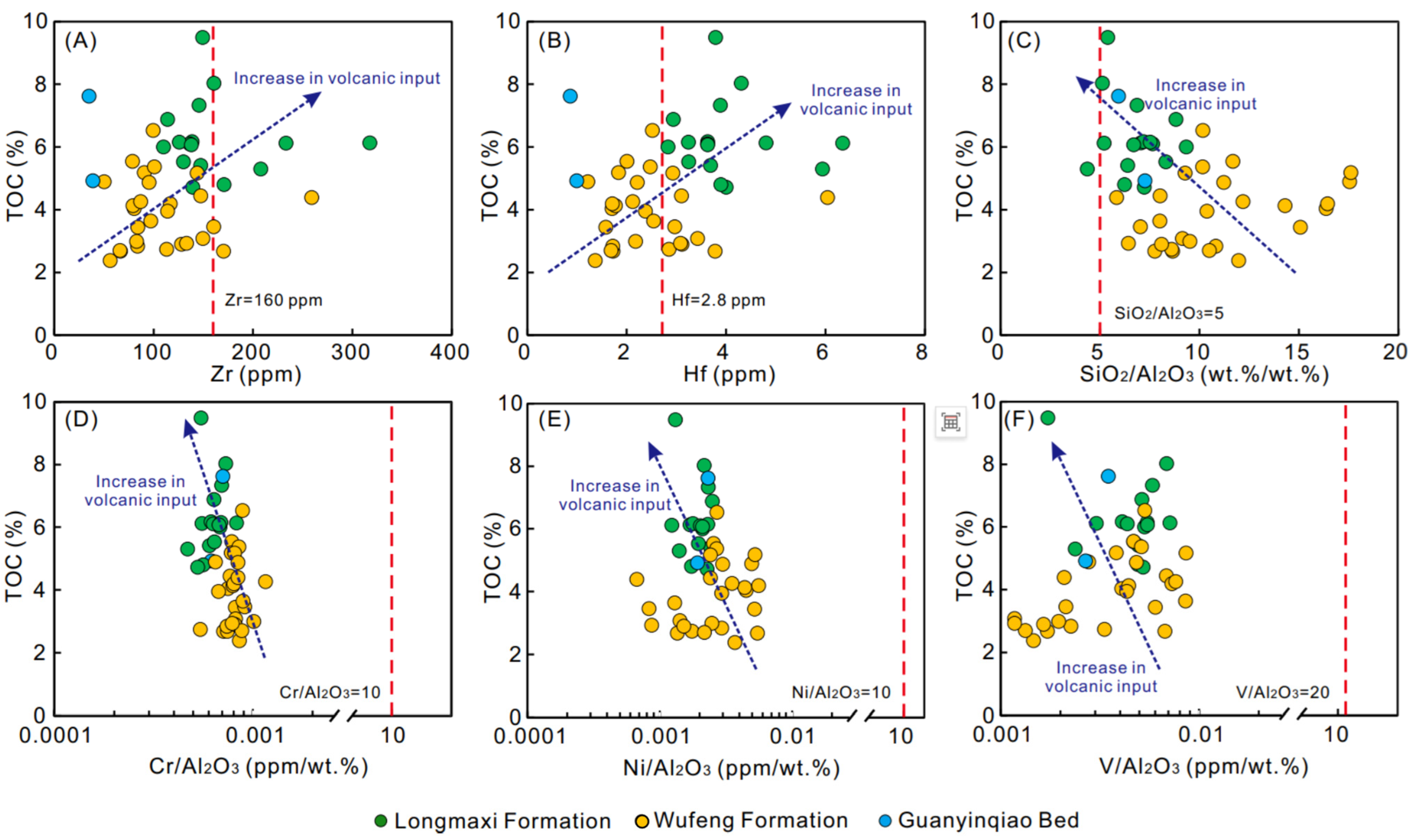
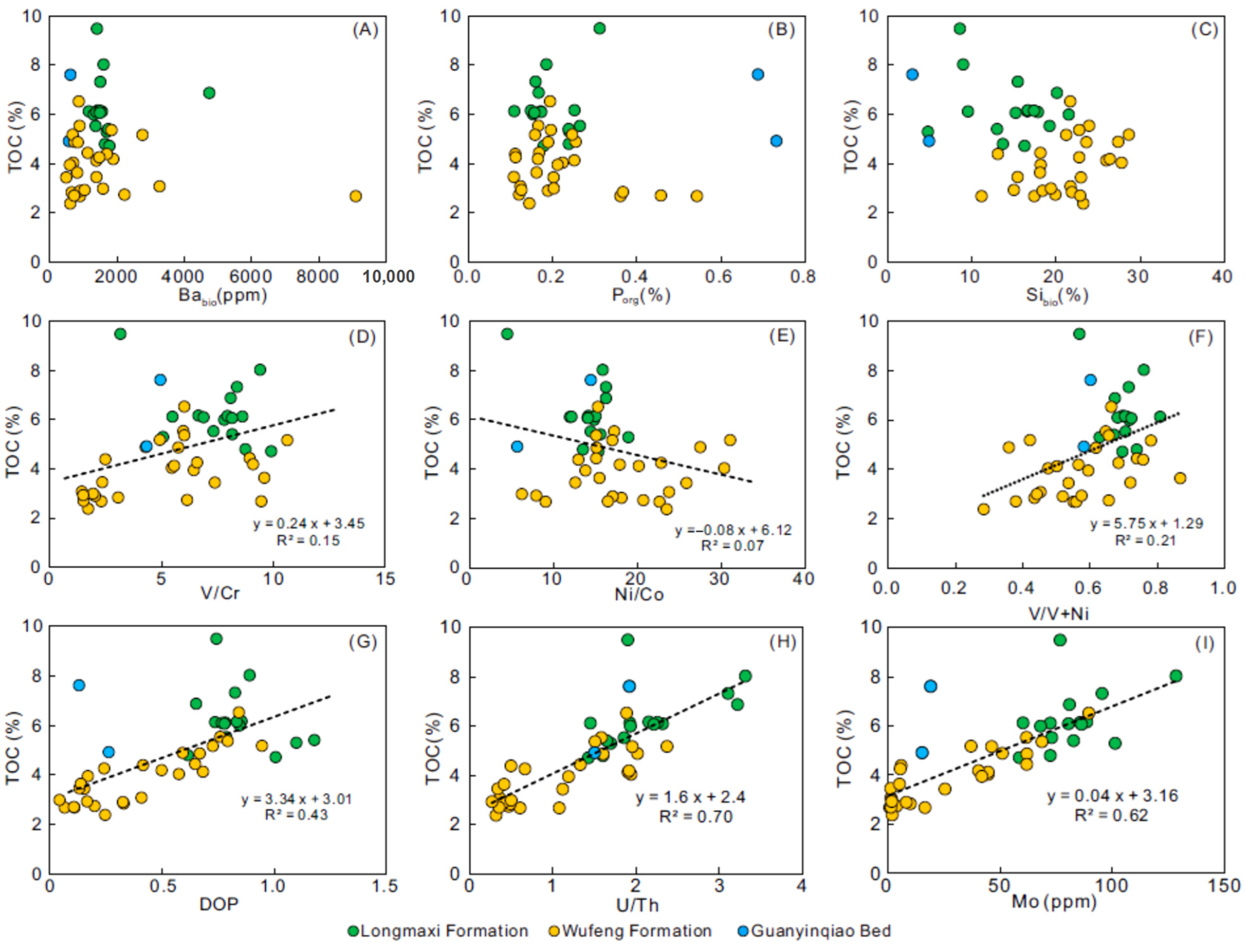
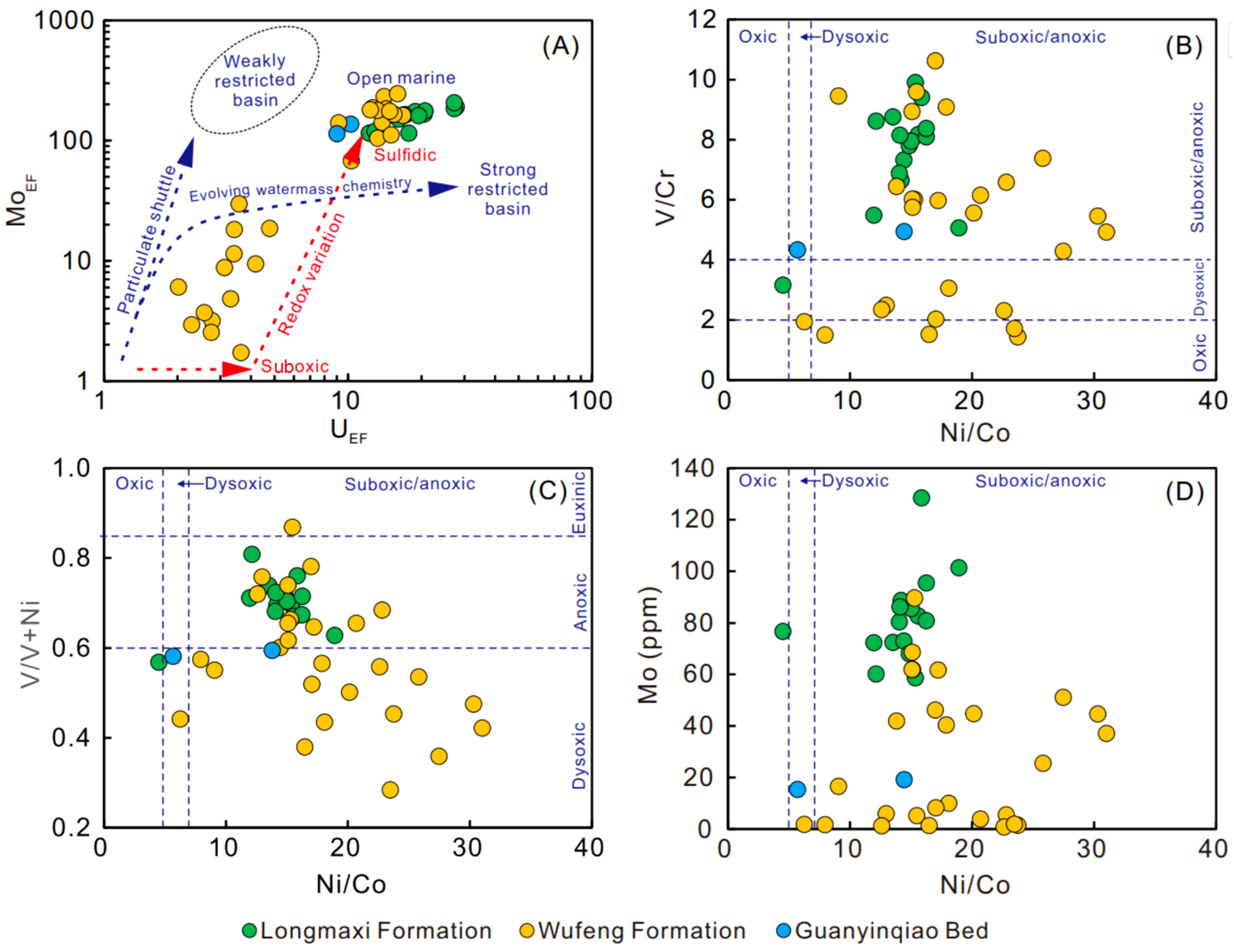
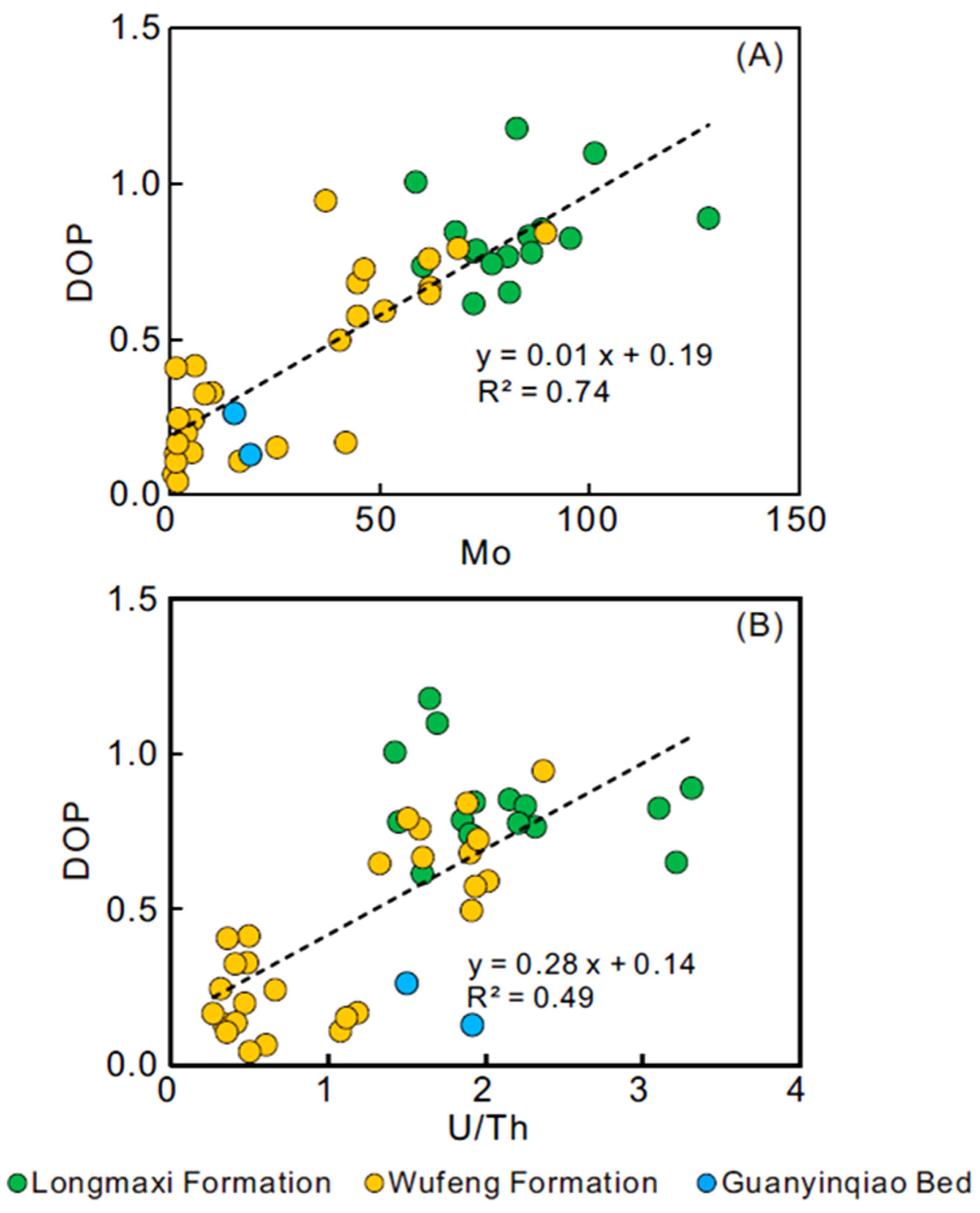
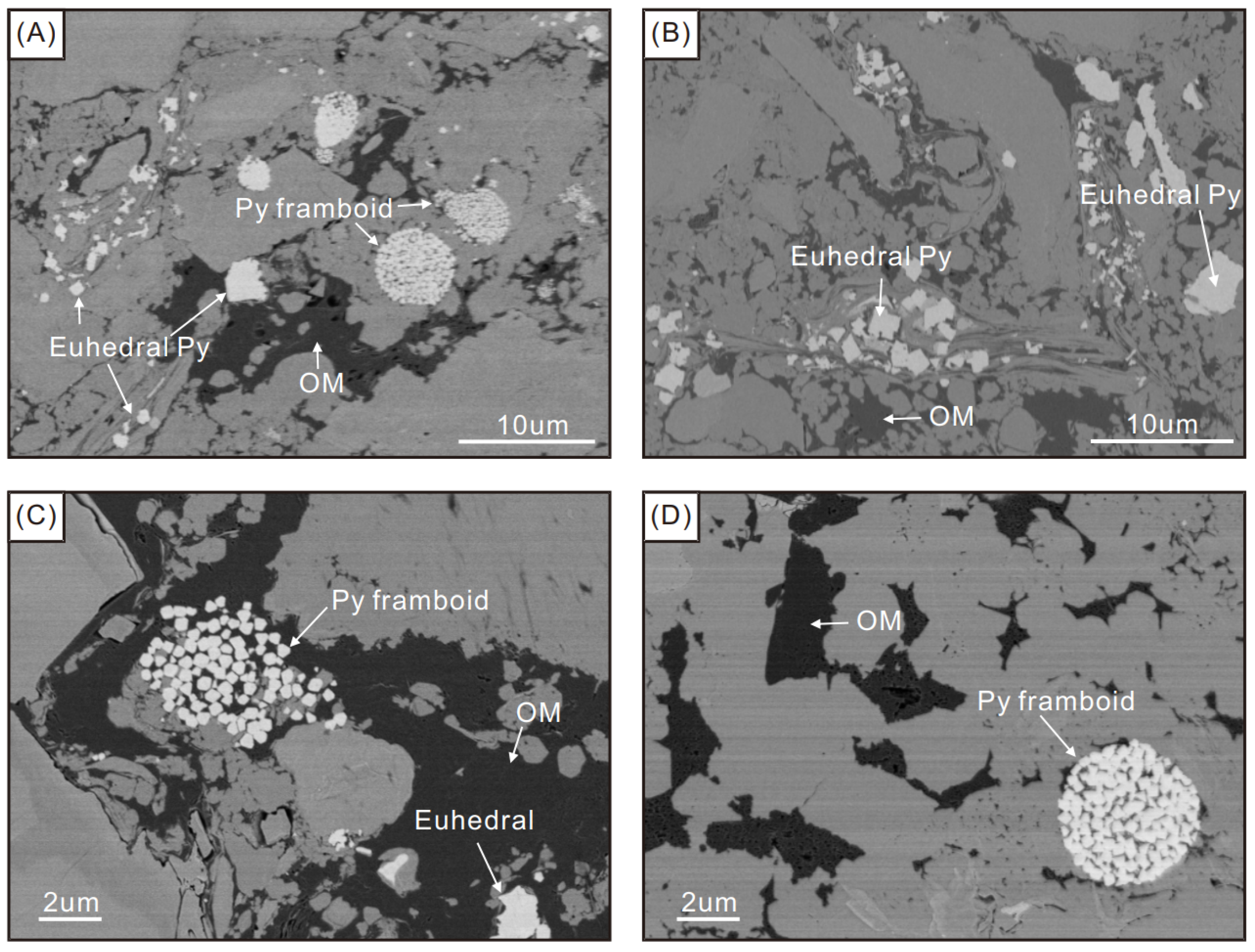
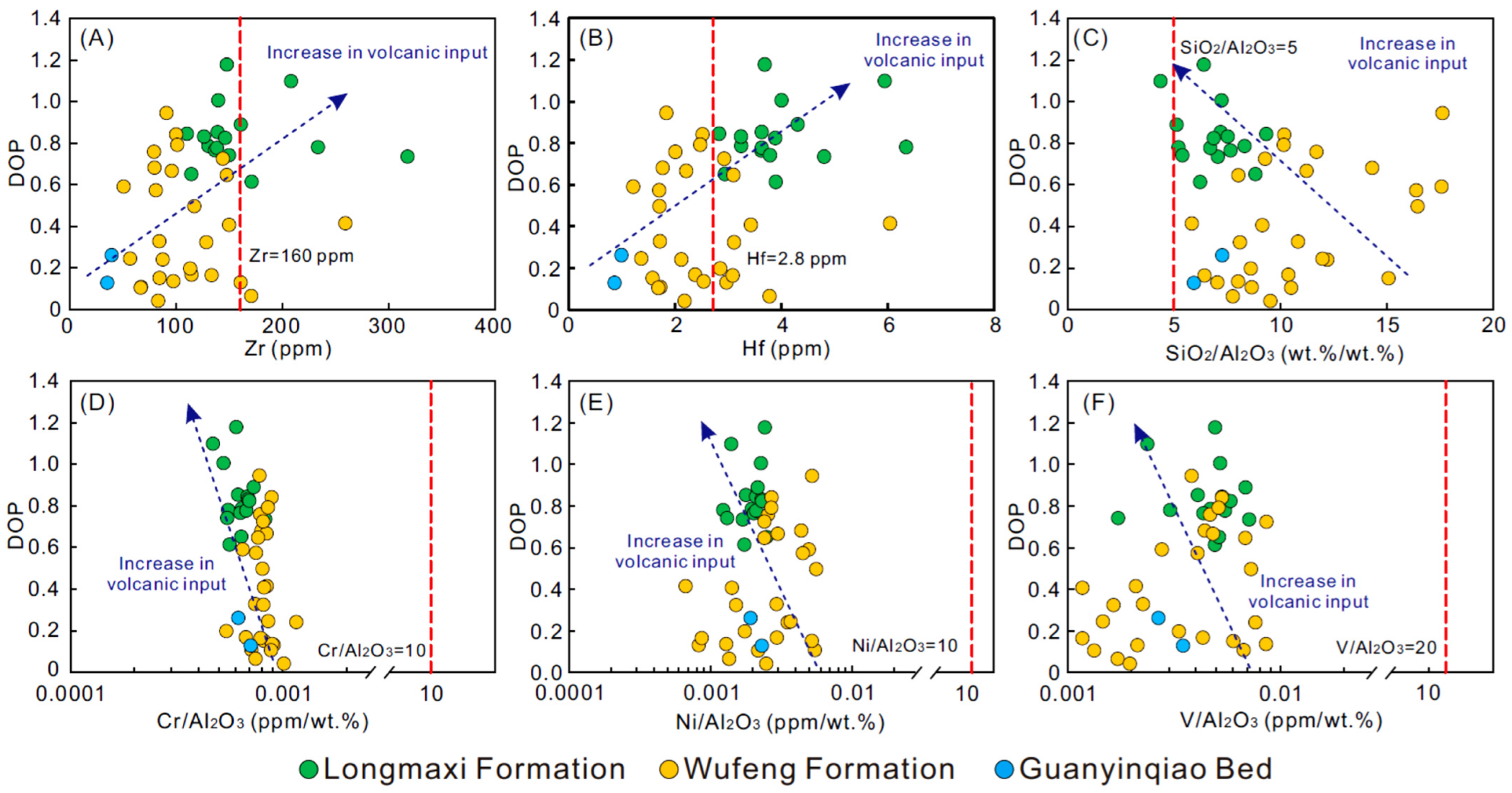

Disclaimer/Publisher’s Note: The statements, opinions and data contained in all publications are solely those of the individual author(s) and contributor(s) and not of MDPI and/or the editor(s). MDPI and/or the editor(s) disclaim responsibility for any injury to people or property resulting from any ideas, methods, instructions or products referred to in the content. |
© 2025 by the authors. Licensee MDPI, Basel, Switzerland. This article is an open access article distributed under the terms and conditions of the Creative Commons Attribution (CC BY) license (https://creativecommons.org/licenses/by/4.0/).
Share and Cite
Li, S.; Zhu, Z.; Xiao, Q.; Cai, S.; Li, H. Linking Volcanism, Hydrothermal Venting, and Ordovician/Silurian Marine Organic-Rich Sediments in the Eastern Sichuan Basin, Southwest China. J. Mar. Sci. Eng. 2025, 13, 483. https://doi.org/10.3390/jmse13030483
Li S, Zhu Z, Xiao Q, Cai S, Li H. Linking Volcanism, Hydrothermal Venting, and Ordovician/Silurian Marine Organic-Rich Sediments in the Eastern Sichuan Basin, Southwest China. Journal of Marine Science and Engineering. 2025; 13(3):483. https://doi.org/10.3390/jmse13030483
Chicago/Turabian StyleLi, Shaojie, Zhou Zhu, Qilin Xiao, Suyang Cai, and Huan Li. 2025. "Linking Volcanism, Hydrothermal Venting, and Ordovician/Silurian Marine Organic-Rich Sediments in the Eastern Sichuan Basin, Southwest China" Journal of Marine Science and Engineering 13, no. 3: 483. https://doi.org/10.3390/jmse13030483
APA StyleLi, S., Zhu, Z., Xiao, Q., Cai, S., & Li, H. (2025). Linking Volcanism, Hydrothermal Venting, and Ordovician/Silurian Marine Organic-Rich Sediments in the Eastern Sichuan Basin, Southwest China. Journal of Marine Science and Engineering, 13(3), 483. https://doi.org/10.3390/jmse13030483




